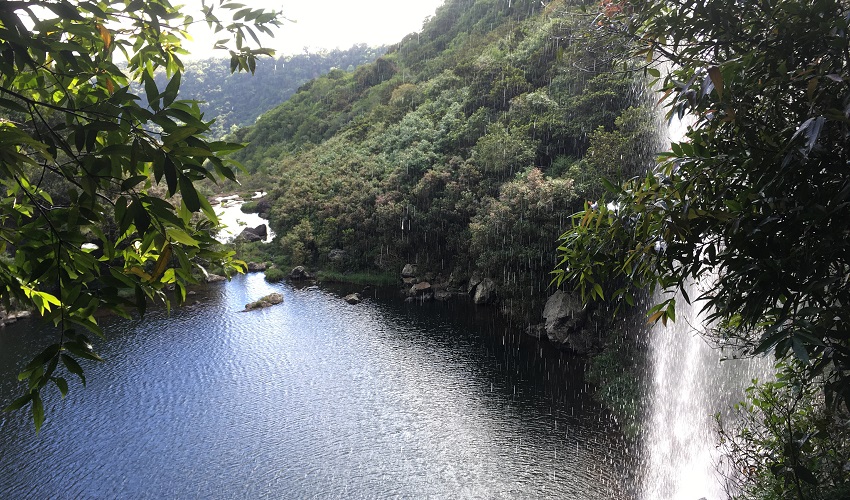Blog: World Water Forum 8 - Insights from a newcomer
By Pelle Bagesund - As a participant at the World Water Forum I was most interested in presentations related to ecosystem valuation and payment for ecosystem services (PES).

Photo: Pelle Bagesund
 Photo: Pelle
Photo: Pelle
I work as a Junior Professional Officer in the IUCN ESARO (East and Southern African Region) based in Pretoria, as part of the Swedish International Development Agency (Sida) agreement. As part of my training I had the opportunity to attend the World Water Forum in Brasilia where the world’s water experts gathered for a week to discuss and share experiences on the most urgent water-related challenges.
Ecosystem services have during the last decade become a key topic within environmental discussions and this was also true during the Forum. Ecosystem services were studied extensively in the Millennium Ecosystem Assessment (MA) and put a lot of focus on the many ways in which the natural environment provides benefits to, and sustains, human life. Examples of these ecosystem services are soil formation, plant pollination, food production, but also regulating services and cultural values like flood regulation, water purification, aesthetic, recreational and spiritual values.
My entry into this topic is mainly through my main field of work which is Ecosystem-based Disaster Risk Reduction (Eco-DRR). In this field, the regulating of ecosystem services plays a key role in particular through flood regulation but also through climate regulation, disease regulation and water purification. The issue in terms of valuing ecosystem services is how we can properly estimate the value of, for example, a mangrove forest that protects a coastal community from storm surges or a mountain forest that protects the communities down the hill from floods and landslides. In comparison it is easy to estimate the costs of a grey infrastructure project, it has its budget, its timespan and its operational lifetime. The benefit of grey infrastructure is also the fact that results are achieved within a clear timeframe; when the project is done the benefits of it will be there.
For green infrastructure this is not the case as the benefits take time to achieve as the ecosystem needs to go through developing stages in order to reach the stage where it actually provides the wanted services. The IUCN`s project WISE-UP is working specifically on this and was covered in a very stimulating session during the World Water Forum led by James Dalton. The ESARO part of the project is in Tana River in Kenya where the project is working with generating new knowledge and innovation on optimizing combined built and natural infrastructure.
Recently I have also been especially interested in the concept of payment for ecosystem services (PES), a system where the users of a particular ecosystem service pay to conserve the ecosystem that is providing the service. One part of SUSTAIN`s work in Mozambique, has been to look at how PES schemes can create partnerships in the landscape between different actors.
The Nature Conservancy`s presentation on water funds and how these have been beneficial in connecting downstream water users in rivers systems with conservation actions upstream in a PES scheme was packed full of information. I got even more interested when the second presentation during this session was on water fund establishments in eastern and southern Africa.
This led to a very interesting talk with the Nature Conservancy colleague from Cape Town and a decision to follow to see if we can find synergies on working with PES in the region.
My responsibility during the World Water Forum was also to assist in the pavilion coordination and session management but I also had a mission from Sida to manage their Instagram account for a week where I covered my work at IUCN and the attendance to the World Water Forum. As part of this I covered sessions with connections to this, one of them was the SIWI (Stockholm International Water Institute) session with the announcement of the Stockholm Water Prize that this year went to the biotech pioneers Bruce Rittmann and Mark van Loosdrecht for revolutionizing water and wastewater treatment (read more here). Next big event in the world of water is the World Water Week in Stockholm in August.
Apart from this I also attended a session on SUSTAIN where Isabelle Fauconnier, Water Policy and Sustainability Advisor in IUCN headquarters, and Mampiti Matete, Technical Coordinator for Water in ESARO, shared a lot of interesting experiences on working with SUSTAIN. The key lesson for me from the Forum was how a water fund (like the case presented by The Nature Conservancy) can be an alternative to PES in order to connect downstream water users and upstream conservation actions to protect the provision of water purification to the downstream users. This is something that inspires me and I will continue to research this in my work in Southern Africa. With this I conclude a very interesting and active week at the World Water Forum.
***
Pelle Bagesund is based in Pretoria, South Africa and can be reached via email per-martin.bagesund[@]iucn.org



